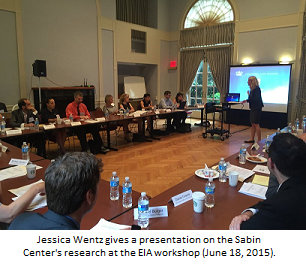By Julia Ciardullo
Fellow
There have been a number of interesting legal developments in recent months that highlight the importance of intellectual property law in the field of green technology. This post is the first in a series of blogs that will summarize some of the most notable legal developments, starting with a discussion of government initiatives. Future posts will discuss a number of major pending litigations whose decisions could have an impact on wind, solar, and other green technology patents.
Expiration of the USPTO’s Green Technology Pilot Program
On December 11, 2009, the US Patent and Trademark Office (“USPTO”) commenced its Green Technology Pilot Program (“Pilot Program”), which provides for accelerated examination of patent applications related to green technologies. The USPTO typically takes 30 months to perform an initial examination of a filed patent application, and 40 months to render a final disposition. Under the Pilot Program, however, an applicant is able to have an application reviewed within only a few months, and receive a final disposition within one year. To be eligible for the Pilot Program, a patent application has to pertain to green technologies such as greenhouse gas reduction, environmental quality, energy conservation or development of renewable energy resources.
The Pilot Program was originally set to expire on December 8, 2010, or the date that 3,000 applications had been granted special status under the program, whichever came first. The response to the Pilot Program was initially sluggish, and the USPTO extended the program through December 31, 2011. On December 15, 2011, the Pilot Program was further extended until March 30, 2012, or the date that 3,500 applications had been granted special status under the program. On February 27, 2012, the USPTO announced that 3,500 applications had been granted special status and the Pilot Program was officially closed.
America Invents Act
On September 16, 2011, President Obama signed into law the Leahy-Smith America Invents Act (“AIA”), introducing the most significant changes to US patent law since 1952. The AIA does not single out green technologies for special treatment, but it does fundamentally impact the way all technology companies will go about procuring patents. Perhaps the most important provision of the AIA is its mandate that the US shift from a “first-to-invent” system to a “first-to-file” system by March 2013. Most other countries have long operated under a first-to-file system, which awards priority among competing inventors to the one who files a patent application first, regardless of who may have first conceived of the invention. Although this bright line rule will reduce the number of litigations concerning inventorship, it will undoubtedly spur a “race to the patent office” among technology companies who will likely file many more provisional patent applications (streamlined, low-cost submissions that allow an inventor one year to decide whether to pursue a complete nonprovisional application), a greater percentage of which may suffer defects as a result of having been rushed.
Among many other changes to the patent laws, the AIA permits prioritized examination of patent applications: upon payment of $4,800 fee ($2,400 in the case of individuals and small entities), an applicant can receive a final determination on an application within one year of filing instead of the typical 40 months. In the wake of the expiration of the Green Technology Pilot Program, green technology companies interested in prioritized examination of their patent applications will be able to take advantage of this procedure.




